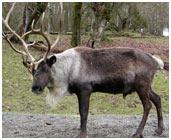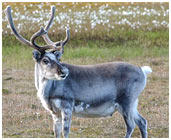Reindeer is one of the species of deer and is found mainly in the tundra region of the world. Check out some interesting and amazing, facts and information on reindeer.
Facts About Reindeer
Reindeer, also known as caribou, belongs to the family of deer (Cervidae) and is basically found inhabiting bleak arctic plain, or tundra, and the surrounding forest and mountain areas. The wild reindeer can be found in Norway, Siberia, Greenland, Alaska and Canada in large population and about 50 of them are seen around the Cairngorms region in Scotland. The domesticated reindeer inhabits Northern Fennoscandia, Russia and Ireland. It survives on a diet of mainly lichens, mosses, leaves of willows and birches, sedges, grasses and stunted shrubs and has an average lifespan of twelve to fifteen years. Reindeers are extremely strong as these can carry heavy loads. These have sharp hooves, which enable them to walk on snow and ice. Reindeers can shed their antlers during the winter and new antlers grow in their place. In the following lines, we have provided some more interesting facts and amazing information on reindeer.

Fast Facts
Bionomial Name: Rangifer tarandus
Class: Mammalia
Order: Artiodactyla
Family: Cervidae
Subfamily: Capreolinae
Genus: Rangifer
Species: R. tarandus
Height (shoulder): 3-4 ft
Length: 48-86 inches
Weight: 200-600 lbs
Color: Brown
Age: 12-15 years
Natural Habitat: Frozen arctic tundra region
Diet: Lichens, mosses, grasses
Reproductive Age: 29-41 months
Number of Offspring: Usually One
Gestation Period: About 8 months
Interesting & Amazing Information On Reindeer
- Reindeer are excellent swimmers and can easily swim across wide rivers.
- They live together in large groups, known as herds, the smallest of which contains usually 20 members. On the other extreme, large herbs of reindeer might comprise of thousand members also.
- Male reindeer are solitary, while female reindeer tend to stay in herds.
- In summers, reindeer migrate long distances to the north, for fresh grazing and come back to the more temperate climates of the south, in winter, for shelter.
- A reindeer’s coat is usually brown, with a pale breast and belly in summers, while the coat turns lighter and whitish during the winters.
- A single reindeer male, known as bull, wins control over a harem of 5 to 15 females, known as cows, in the mating season.
- The calf of a reindeer weighs 11 - 20 pounds and can stand on its legs within minutes of being born.
- A day-old reindeer calf is capable of outrunning a man.
- Reindeer is the only deer that can be domesticated. It provides butter, meat, cheese, clothing and transportation to humans.
- Male reindeer shed their antlers at the end of winter season, after the rut, and grow them again around January-February.
- Female reindeer and calves shed their antlers around March-April and start growing new ones immediately after shedding the old ones.
- The inflatable pouches of skin found under the reindeer’s throat amplify the roaring during rutting season.
- Reindeer can lower the temperature in their legs to just above freezing, in extremely cold weather. This way, they avoid loss of body heat.
- In winters, the facial hair of reindeer grows down to the lips, to protect the muzzle when reindeer graze in snow.
- Reindeer represent the only deer species, apart from caribou, in which males, females and even calves produce antlers.
- Reindeer milk is very high in protein and fats.
- In winters, reindeers prefer snow, over water.
- Reindeers always live in forests.
- The noses of reindeers are capable of warming the air they breathe into their lungs.
- During summer, their hooves expand in size and in winters they shrink.
- Reindeers have two layers of fur. The initial layer is thick and woolly and the next layer contains hollow hair to protect the body from extreme cold temperatures.
- Scientists claim that reindeers are the only creatures that are able to see ultraviolet light.
- Reindeers essentially feed on moss, sedges, mushrooms and grass; although evidences reveal that these also feed on arctic char, bird eggs and lemmings.
- A reindeer can travel about 35 miles a day, making these one of the most resourceful animals.
- Reindeers have efficient sense of smell, which enables them to search for food easily.


See also
More from iloveindia.com
- Home Remedies | Ayurveda | Vastu | Yoga | Feng Shui | Tattoos | Fitness | Garden | Nutrition | Parenting | Bikes | Cars | Baby Care | Indian Weddings | Festivals | Party ideas | Horoscope 2015 | Pets | Finance | Figures of Speech | Hotels in India : Delhi | Hyderabad | Chennai | Mumbai | Kolkata | Bangalore | Ahmedabad | Jaipur
- Contact Us Careers Disclaimer Privacy Policy Advertise With Us Lifestyle Sitemap Copyright iloveindia.com. All Rights Reserved.




